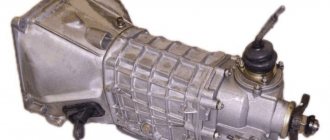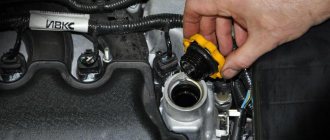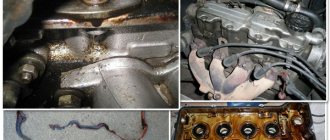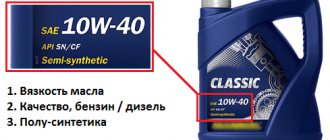When checking the oil level in the gearbox again, many car enthusiasts are surprised to find that the dipstick is completely covered with small bubbles. Foam in the oil indicates a gearbox malfunction, which can be quite dangerous for this unit. Foaming results in increased wear and tear on internal components that no longer lubricate properly. In addition, the gearbox begins to overheat, which leads to difficult gear shifting, failure of the control electronics, and in worst cases, breakdown of the entire unit. To find out why gearbox oil foams and how to get rid of this problem, you should read the following article.
Foam in the oil can significantly impair transmission performance.
Mixing
Car maintenance is not an area where you should mix different liquids like a medieval alchemist. This is forgotten by many thrifty owners who try to get by with low expenses when repairing a gearbox. Mixing two types of oil belonging to different classes or even produced by different companies can lead to foaming due to chemical reactions between additives and other components of lubricants. What’s much worse is that when two oils are mixed, the resulting liquid practically loses its properties, as a result of which gearbox wear accelerates several times.
There can only be one way out - the oil must be drained and replaced with a new one. However, in some places of the gearbox there may be drops and leaks of old process fluid. To avoid this, it is necessary to flush the transmission with a special fluid that removes all active chemical compounds. The best option is to contact a service station to completely eliminate the possibility of the unit breaking. But if you have some technical skills, you can do the washing yourself.
A fitting is soldered into the bottom of a five-liter plastic bottle, and a nipple from a regular tire is soldered into the lid. After filling the container with flushing fluid, connect the input hose from the gearbox to the fitting, and the compressor to the nipple. After unscrewing the outlet hose and placing its end in a sufficiently large container, turn on the compressor. You must wait until clean flushing fluid without traces of old oil flows out of the outlet hose. Be very careful - if the gearbox design has a filter, it must be removed before washing and a new one installed before adding new oil.
Causes of automatic transmission oil foaming
Many factors can cause foam to form in transmission oil. Troubleshooting should always start with diagnosing and identifying the cause. This will make it easier to remove foam and prevent its further formation. Below we will examine all the reasons why automatic transmission oil foams.
Incorrect mixing
When it is necessary to replace technical fluids, in particular transmission oil, many car owners succumb to the temptation to save money. The fluids are not completely changed, but new oil is added to the required level. In this case, different liquids are mixed, which is unacceptable. Liquids produced by different manufacturers or with different markings should not be mixed with each other, otherwise foam may form.
Why does the oil foam in the gearbox? It's all about the chemical reactions that occur between the components of different lubricant compositions. This situation leads to the loss of the protective and operational properties of the lubricant.
There is only one way out of this situation - a complete replacement of the composition poured into the gearbox. All contents are drained, and the mechanism is washed using a special composition. It is important to use a special flush, as it can remove the remains of old grease that is unusable. The washing process must be repeated until there are no traces of oil left in the liquid. Before washing, you must remove the filter, if present. Before filling in new lubricant, the filter element is installed in its original place.
Abnormal oil level
The lubricating fluid must be held at a certain level, which is optimal for the normal operation of the device. An excess, as well as a deficiency, is a violation of the operation of the car, which will certainly lead to serious consequences if it is not eliminated in a timely manner.
There is an opinion among motorists that a slightly too high oil level in the gearbox has a beneficial effect on its operation. This statement is only true for some car models, and in most cases it is incorrect. Unfortunately, many drivers listen to this judgment and violate the standards set by the car manufacturer. For example, Mercedes-Benz, Toyota, Volkswagen, BMW cars are extremely sensitive to excessive oil levels in the transmission. Overfilling of lubricant can lead to torn gaskets, faulty valves and failure of clutches.
Abnormal level
Most often, automatic transmission oil foams when there is too much oil. Many owners, having listened to experienced mechanics, try to add much more technical fluid than prescribed in the instructions. However, they forget that such advice is not suitable for all cars. The most sensitive to excess fluid volume are gearboxes made by Volkswagen, Toyota, BMW, and Mercedes. The consequences of such a careless action by the car owner can be broken valves, torn rubber gaskets and even burst clutches.
To check the oil level, use the instructions - it indicates at what temperature this procedure must be performed. Most often, you need to drive 5 kilometers, then stop the car, wait a couple of minutes until the foam settles, pull out the dipstick, wipe it and reinsert it. The result will show whether the gearbox is overfilled with oil. Excess levels should be disposed of immediately - to do this, part of the oil is drained.
The cause of foaming may be an insufficient level of technical fluid - this is true for both automatic and manual transmissions. Checking the oil level is carried out in the same way. If you do not add it to the gearbox in time, you may soon encounter a breakdown even of that transmission model that is considered “eternal.”
Causes and remedies for oil foaming in the gearbox
A routine check of the oil level in the gearbox can result in an unpleasant surprise in the form of foaming gear oil.
Foaming can be easily identified by a large number of small bubbles on the surface of the dipstick. This symptom indicates a malfunction that can lead to extremely unpleasant consequences. Foam does not allow components to be lubricated properly, which leads to overheating, electronic malfunctions, difficulties during gear shifting, or even serious damage. We will look into why the oil in the gearbox foams in this article. Sometimes when checking the oil level you may find bubbles on the dipstick.
Flow
The reason for the appearance of foam in the gearbox may be the entry of a large amount of air and its gradual replacement of oil. This happens when the hose ruptures or the body of the unit is damaged, for example, a crack or a small hole. Without repairing the damage to the gearbox, you cannot continue driving, since the quality of lubrication of the rubbing parts will deteriorate with each kilometer traveled. During an external inspection, you should pay special attention to the following areas of the transmission:
- The lower part of the body;
- Connecting plate between gearbox and engine;
- Hoses, seals, rubber gaskets and rings.
Continued use of the gearbox may lead to dire consequences.
After repairing the damage, it is recommended to replace the oil in the gearbox to avoid the consequences of air and dirt getting into it.
If the gearbox has a cooling system from a dual-circuit radiator, the cause of foaming may be the leakage of technical fluid from it, which differs in properties from oil. The breakdown must be repaired immediately, since not only the transmission is at risk, but also the power unit. After this, the gearbox is washed, the oil is completely changed and the car continues to be used as normal.
Why does gearbox oil foam and how to deal with it?
The car's gearbox contains oil, which must be periodically checked, its condition assessed and, if necessary, replaced. During the next such check, small bubbles may be detected on the dipstick. This situation will indicate the presence of problems in the operation of the gearbox. If appropriate measures are not taken, the working unit will wear out intensively and will soon fail.
As a result of oil foaming, the effectiveness of lubrication of the internal parts of the mechanism decreases. The box heats up intensely, gears are more difficult to shift, the electronics cannot cope with the load and ultimately the entire mechanism fails. Next, you will need expensive and complex repairs or a complete replacement of the entire box.
It is necessary to respond to such a situation in a timely manner, immediately carry out diagnostics and eliminate the cause of the appearance of foam in the lubricant. We have to understand a complex and important problem that can affect every motorist.
Negligence
Foam in oil can appear when the technical fluid loses its properties as a result of prolonged use. Of course, in the car's instructions, oil change intervals are indicated with a significant margin, but when they are exceeded twice, foam often appears in the gearbox, the formation of which significantly increases the rate of wear of internal components. To prevent this from happening, experts recommend changing the oil:
- Mineral in automatic transmission - every 20–30 thousand kilometers;
- Synthetic in automatic transmission - at least 50 thousand kilometers;
- Mineral in manual transmission - every 30 thousand kilometers;
- Synthetic in manual transmission - at least 70 thousand kilometers;
- Synthetic in the variator - at least 30 thousand kilometers.
Timely oil changes will protect the gearbox from early breakdown
Foaming is also often a consequence of oil overheating due to overly active driving. In cars with automatic transmission, a special light on the dashboard warns of reaching a critical temperature, but owners of cars with manual transmission have to only guess about the level of this indicator. If you plan to use your car for sports competitions, be sure to equip it with an engine and transmission oil temperature gauge - this will help you know when to slow down to avoid car damage.
If you pay attention to the section of the instructions that talks about changing the oil in the gearbox, you may notice information about a possible change in the frequency of the procedure. If the car is used in the city, often sits idle in traffic jams, or goes off-road and is subjected to increased loads, the oil should be changed 1.5 times more often. When a car spends most of its time not on a country highway, but in the described conditions, foam may appear in the gearbox even before the oil life is exhausted. You should change the oil, and then check the presence of foam in it and the level. If the problems do not disappear, you should contact professionals who will conduct a comprehensive diagnosis and find the cause as soon as possible.
Useful tips and tricks
Please note that if large and sparse air bubbles are visible on the dipstick when checking, this does not indicate that the oil is foaming. If the engine and gearbox have recently been operating in active mode at high speeds, isolated bubbles are allowed in the wave and this is the norm. Foamed oil is a fairly evenly foamed liquid with small air bubbles.
You also need to take into account that if there is little foam, this leads to an increase in its volume, then when checked, the level will be too high. To accurately determine the level, you need to warm up the automatic transmission, then turn off the engine and let the oil settle.
If there is an overflow of oil into the automatic transmission, foaming will not occur immediately after starting the engine, but after driving under load and at high speeds. In this case, foaming will also increase the volume of the liquid. In this case, excess oil will be squeezed out through the gearbox breather. To confirm, you can inspect the gearbox and the location of the breather. If there is overflow, the breather will be in oil, and it is also quite possible for the entire box to become oily.
Finally, we note that often, especially when installing contract automatic transmissions on a car, a new engine and automatic transmission oil dipstick is installed before sale. At the same time, probes for different models may fit the neck, but differ in length.
So, if the dipstick level is below normal, but the oil foams and ATF “drives” through the box breather, there is a high probability that the dipstick is not entirely suitable for this automatic transmission. In such a situation, the box kicks, the owner believes that the level is low and adds oil. However, in reality there is an overflow with all the ensuing consequences.
Immediate repair
After determining the cause of foam in the transmission oil, you should immediately begin to eliminate it. In the absence of any action, after 10–20 thousand kilometers, the cost of work will increase tenfold, since worn-out internal components will be added to the unnatural state of the oil. First, you should check whether the recommended oil level is accurately maintained and make changes if necessary. It is also advisable to change the technical fluid to avoid recurrence of the problem. If you cannot determine the cause of the problem yourself, you should contact a service station with a good reputation, without delaying your visit to the specialist for a long time.











